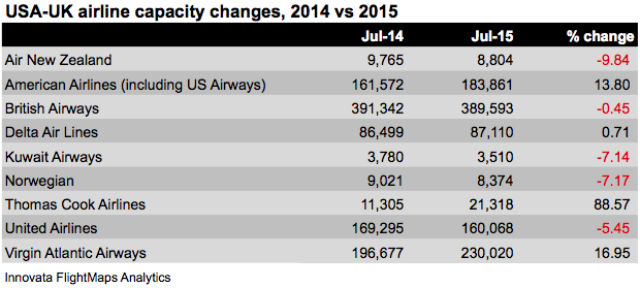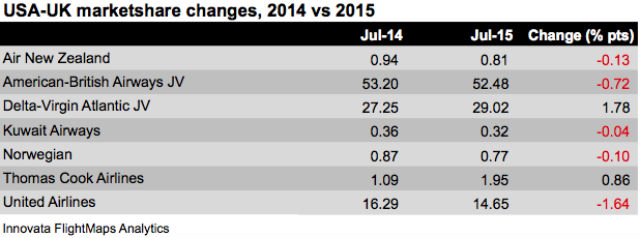A slew of new nonstop routes between the USA and the UK will drive up capacity during the summer of 2015, surpassing the peak set in 2014.
Scheduled capacity between the two countries will increase 5.14% to 1.09 million seats in July 2015 – when all of the seasonal routes in the market will be operating at their peak – compared to a year earlier, Innovata FlightMaps Analytics shows. Frequencies will increase 6.1% to 4,103.

The growth is lower than during this past July. Seat capacity in the market increased nearly 7% year-over-year during the month, Innovata shows. This was driven by strong demand but also resulted in declining yields as competitive capacity increased rapidly across the Atlantic, airline executives said at the time.
Driving this growth in 2015 are significant capacity increases at American Airlines and its subsidiary US Airways, Thomas Cook Airways and Virgin Atlantic Airways, Innovata data shows.

The largest capacity increase is at Thomas Cook where seats will jump nearly 89% to 21,318 in July 2015. The UK-based leisure carrier plans to add five new routes in the market by July: Belfast-Las Vegas, London Gatwick-Las Vegas, London Gatwick-Orlando, Manchester-Miami and Manchester-New York JFK. They will all be flown with Airbus A330 aircraft.
Thomas Cook chief Christoph Debus told Flightglobal this past April that the new routes gave business and leisure travellers “new and alternative” options to New York and other destinations from the UK.
Capacity on Virgin Atlantic will rise 17% in July 2015 versus a year earlier. This is driven by the decision to end service to Cape Town, Mumbai, Tokyo Narita and Vancouver and shift the freed up aircraft to the USA-UK market to take advantage of its immunised joint venture alliance with Delta Air Lines.
However, many of the UK-based carrier’s new flights are simply replacing ones already operated by its partner. New nonstop service will be added between Belfast and Orlando on a Boeing 747-400 from 25 June 2015 to 23 July 2015, as well as additional frequencies between London Heathrow and both Los Angeles and New York JFK.
“We didn't have a goal to move from east to west or try and become more US-centric," said Craig Kreeger, chief executive of Virgin Atlantic, following the network change announcement in October. "It wasn't about a goal to be bigger in transatlantic [but about] where we think we could serve customers more successfully.”
Virgin Atlantic’s partner Delta Air Lines will see a 0.7% increase in seat capacity this coming July as it begins new service between New York JFK and Manchester with a Boeing 767-300ER on 2 June 2015 and between Philadelphia and London Heathrow with a Boeing 757-200 on 8 April 2015.
American will post the third fastest growth between the USA and UK in July, with seat capacity up 13.8%, Innovata data shows. This comes as it adds new daily service between New York JFK and both Birmingham and Edinburgh, though the latter replaces a flight from Philadelphia, on 757-200s. The Birmingham flight will operate from 7 May 2015 and the Manchester flight for the summer season.
The Fort Worth, Texas-based Oneworld alliance carrier will also add a second daily Los Angeles-London Heathrow flight on a Boeing 777-300ER from 28 March 2015 and a second daily Philadelphia-London Heathrow flight on a 757-200 from 29 March 2015.
Though capacity on United Airlines between the USA and UK will shrink by 5.45% in July, the Star Alliance carrier does plan to add a new seasonal daily nonstop between Newark Liberty International airport and Newcastle on a 757-200 from 23 May 2015 through 7 September 2015.
As a result of the seat capacity changes, the American-British Airways joint venture will see its share of the market shrink less than one percentage point to 52.5% and the Delta-Virgin Atlantic joint venture increase its share by nearly two points to 29%. United will remain the third largest carrier with a 14.7% share.

Carriers still need to watch their capacity growth. Raymond James analyst Savi Syth says in a recent report that airlines have stabilised yields after pressure this past summer by pulling back planned capacity increases or cutting capacity across the transatlantic. However, she notes that schedules are starting to show an uptick in growth from the second quarter of 2015 that could create concerns for yields.
Source: Cirium Dashboard
















